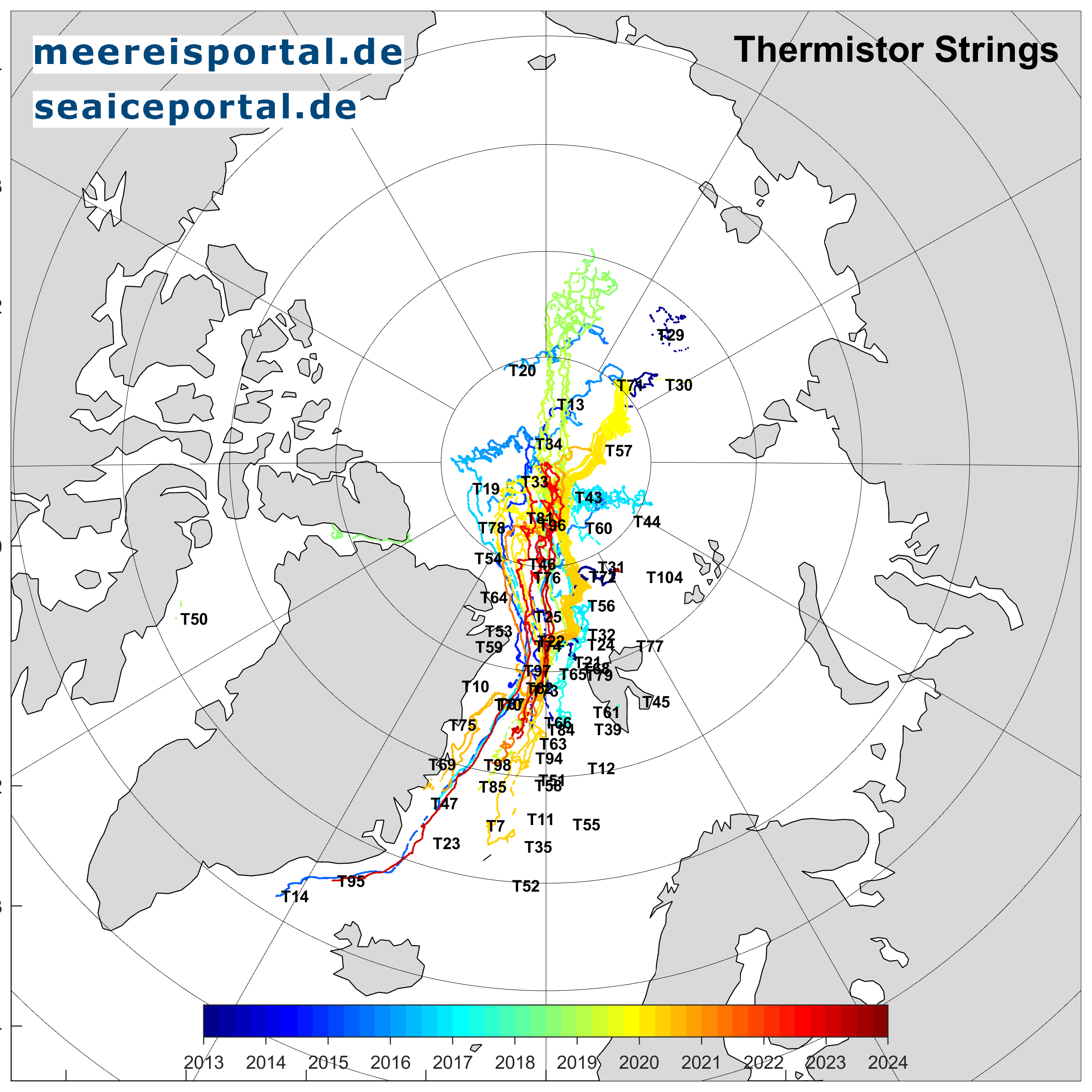Creating A Decade Worth Of Arctic Sea Ice And Snow Thickness Data From Buoy-Based Temperature Measurements
by Andreas Preußer (Alfred Wegener Institute, Helmholtz Centre for Polar and Marine Research) | Published: 07-Sep-23 | Last updated: 06-Sep-23 | Tags : Data ice | category: NEWS
In July 2021, the EU-funded Arctic PASSION project started off with the overarching goal to establish and maintain a sustained and accessible all-inclusive observing system that is tuned to the diverse needs of users, ranging from local inhabitants to academia through to industry and decision-makers. The large project consortium of more than 30 partner institutions is subdivided into ten different work packages, each targeting different aspects of the Arctic system as a whole.

Collection of photographs taken during the deployment of various different sea ice mass balance buoy (IMBs) in the Arctic and Antarctic between 2012 and 2022, as illustrated on individual deployment sheets on data.seaiceportal.de
One of the main goals of Arctic PASSIONs work on establishing an adaptive and more complete Arctic observing system, is to improve and complement existing climate monitoring capabilities in the Arctic cryosphere – i.e. the interconnected ocean and land areas covered with frozen water (snow, land ice, sea ice) all of which are subject to the annual cycle of freezing and melting and heavily affected by climate changed induced warming. The usage of autonomous drifting platforms on the polar oceans of both hemispheres has been a main focus of the sea ice physics department at the Alfred Wegner Institute in Bremerhaven (Germany), for roughly two decades. Since the establishment of the sea ice portal, data from these drifting platforms have been increasingly made available in a more unified fashion. Multiple buoy types are now available on the sea ice portal, including the so called thermistor chain buoys or sea ice mass balance buoys – in short “IMB” (for more details, please refer to https://data.meereisportal.de/relaunch/buoy.php?lang=en). As of summer 2023, the IMB archive on the sea ice portal comprises more than 90 individual deployed buoys, each of which spent between a few weeks to almost two years drifting on sea ice.

Schematic of a thermistor buoy (or sea ice mass balance buoy – “IMB”) and its surrounding interfaces & processes (© seaiceportal.de).
Given the geographic setup of the Arctic with its huge ocean area surrounding the pole, regular measurements of sea ice characteristics in this data-wise quite sparse region are of vital importance for further understanding of local physical processes and their representation in climate models.

Overview of thermistor buoy drift tracks in the Arctic between 2012 and 2023
The standard measurements of a “SIMBA” (Snow Ice Mass Balance Apparatus)-type IMB include both a “normal” temperature as well as temperatures measured from the (typically) 241 individual thermistors along a deployed chain (about 5m in length) after heating cycles of different durations. While these quantities are quite useful on their own (e.g., for relating them to satellite-based sea ice properties), an overarching goal for our group in Arctic PASSION is to enhance their value by adding consistent data on the vertical boundaries between atmosphere, snow, sea ice and ocean, which subsequently serve as the baseline for snow and ice thickness estimates for each buoy, as well as other physical parameters of the sea ice at each particular deployment site. The inherent challenge is to derive an augmented processing in a consistent manner that minimizes previous methodological ambiguities
An exemplary figure that shows the snow and ice time series together with the vertical (heating) temperature profiles from buoy “2019T56” (deployed during the MOSAiC expedition in autumn 2019) and buoy “2022T95” (Arctic PASSION deployment during the RV Kronsprins Hakon cruise in summer 2022) is given below. Here, one can easily follow the growth of the sea ice in the course of a freezing season into early melt in spring and summer, as well as evolution of the local snow cover. This is highly valuable information for a variety of further scientific applications such as process studies, evaluation of satellite-based thickness estimates, etc. that will now succeed the initial data set creation phase.


Derived snow- and ice thicknesses (top panels; blue and red lines respectively) for buoys “2019T56” and “2022T95”, together with respective profile time series of recorded environmental temperatures in °C (mid panels) and a thermal proxy as the ratio of heating temperatures after 30s and 120s (lower panels). Manually classified interfaces are marked as black solid lines.
All
in all, the extended buoy processing in Arctic PASSION’s work on establishing an adaptive and more complete Arctic observing system will add value to
establishing a regular in-situ based contribution to respective monitoring
networks in the Arctic. The data set is currently being prepared in
user-friendly formats for a timely release via the PANGAEA data portal, ready to be picked up by anyone who is interested in the wide range of different user groups. The
subsequent task will now be to pull the strings and stories that are embedded
in this decadal data set together. It should not be overlooked that the Arctic tends to change rapidly, a fact often reflected in recorded data. So, exciting times ahead with
more IMB-related science within Arctic PASSION!
